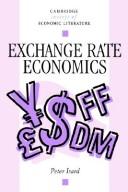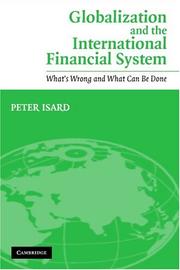| Listing 1 - 10 of 57 | << page >> |
Sort by
|

ISBN: 0521466008 0521460476 9780521466004 9780521460477 Year: 1995 Publisher: Cambridge university press,
Abstract | Keywords | Export | Availability | Bookmark
 Loading...
Loading...Choose an application
- Reference Manager
- EndNote
- RefWorks (Direct export to RefWorks)
International finance --- Quantitative methods (economics) --- Foreign exchange rates --- Econometrics models --- 339.743 --- 330.115.001.57 --- -#ECO:01.08:economie monetair --- #ECO:02.04:financiële sector geldmarkt kapitaalmarkt beleggingen beurs --- taux de change --- politique de taux de change --- modeles economiques --- AA / International- internationaal --- 333.450 --- 333.846.0 --- 333.451.0 --- -332.456 --- Exchange rates --- Fixed exchange rates --- Flexible exchange rates --- Floating exchange rates --- Fluctuating exchange rates --- Foreign exchange --- Rates of exchange --- Wisselkoersen. Wisselkoerspariteiten. Dubbele wisselkoers. Devaluatie. Revaluatie. Zwevende wisselkoers. Muntslang --- Econometrische modellen. Simulatiemodellen --- Econometric models --- wisselkoers --- wisselkoersbeleid --- economische modellen --- Theorie van het deviezenverkeer. Theorie van de koopkrachtpariteit. --- Verband tussen het monetair, bank- en kredietbeleid en de economische ontwikkeling: algemeenheden. --- Wisselmarkt: algemeenheden. --- Rates --- 330.115.001.57 Econometrische modellen. Simulatiemodellen --- 339.743 Wisselkoersen. Wisselkoerspariteiten. Dubbele wisselkoers. Devaluatie. Revaluatie. Zwevende wisselkoers. Muntslang --- 332.456 --- #ECO:01.08:economie monetair --- Theorie van het deviezenverkeer. Theorie van de koopkrachtpariteit --- Wisselmarkt: algemeenheden --- Verband tussen het monetair, bank- en kredietbeleid en de economische ontwikkeling: algemeenheden --- Foreign exchange rates - Econometrics models

ISBN: 0521605075 0521843898 9780521605076 9780521843898 Year: 2005 Publisher: Cambridge, UK: Cambridge university press,
Abstract | Keywords | Export | Availability | Bookmark
 Loading...
Loading...Choose an application
- Reference Manager
- EndNote
- RefWorks (Direct export to RefWorks)
This book provides prespectives on various aspects of the international financial system that contribute to financial crises and growth failures, and discusses the remedies that economists have proposed for addressing the underlying problems. It also sheds light on a central feature of the international financial system that remains mysterious to many economists and most non-economists: The International Monetary Fund and the factors that influence its effectiveness.
Developing Countries --- 333.432.8 --- 334.10 --- 382.11 --- AA / International- internationaal --- Financial crises --- -International finance --- 332.042 --- International monetary system --- International money --- Finance --- International economic relations --- Crashes, Financial --- Crises, Financial --- Financial crashes --- Financial panics --- Panics (Finance) --- Stock exchange crashes --- Stock market panics --- Crises --- Business cycles --- Economic conditions. --- Internationale monetaire organisatie. Internationaal Muntfonds. Algemene leningovereenkomsten. --- Algemene economie : algemeenheden. --- Theorie van het internationale evenwicht. Economische onafhankelijkheid van een natie. Globalisering. Mondialisering. --- International Monetary Fund. --- Mezhdunarodnyĭ vali︠u︡tnyĭ fond --- Международный валютный фонд --- Miz︠h︡narodnyĭ vali︠u︡tnyĭ fond --- Fundo Monetário Internacional --- Fondo Monetario Internacional --- IMF (International Monetary Fund) --- FMI (International Monetary Fund) --- Internationaler Währungsfonds --- Kokusai Tsūka Kikin --- Fonds monétaire international --- Kukche Tʻonghwa Kigŭm --- Kansainvälinen Valuuttarahasto --- Kuo chi huo pi chi chin --- Fondul Monetar International --- Ṣundūq al-Naqd al-Dawlī --- Fondo M. Internacional --- IWF (International Monetary Fund) --- Kō̜ngthun Kānngœ̄n rawāng Prathēt --- MVF (International Monetary Fund) --- Międzynarodowy Fundusz Walutowy --- Mulya Aramudala --- I.M.F. (International Monetary Fund) --- Quỹ tiè̂n tệ quó̂c té̂ --- Nemzetközi Valuta Alap --- صندوق النقد الدولي --- 国际货币基金组织 --- 国際通貨基金 --- 國際貨幣基金組織 --- Fundu Monetariu Internacional --- Ṣundūq al-Naqd al-Duwalī --- DNT (Organization) --- Internationaal monetair fonds --- International monetary fund --- International finance --- Internationale monetaire organisatie. Internationaal Muntfonds. Algemene leningovereenkomsten --- Algemene economie : algemeenheden --- Theorie van het internationale evenwicht. Economische onafhankelijkheid van een natie. Globalisering. Mondialisering --- Developing countries --- Economic growth --- Third World: economic development problems --- International Monetary Fund --- IMF. --- Economic conditions --- International finance. --- Developing countries: economic development problems --- Financial crises - Developing countries --- Developing countries - Economic conditions --- CRISES FINANCIERES --- PAYS EN DEVELOPPEMENT --- FONDS MONETAIRE INTERNATIONAL (FMI) --- FINANCE INTERNATIONALE --- CONDITIONS ECONOMIQUES
Book
ISBN: 1462394426 145527772X 1281600903 9786613781598 1455266515 Year: 1991 Publisher: Washington, D.C. : International Monetary Fund,
Abstract | Keywords | Export | Availability | Bookmark
 Loading...
Loading...Choose an application
- Reference Manager
- EndNote
- RefWorks (Direct export to RefWorks)
This note provides an overview of the uncovered interest parity assumption. It traces the history of the interest parity concept, summarizes evidence on the empirical validity of uncovered interest parity, and discusses the implications for macroeconomic analysis. The uncovered interest parity assumption has been an important building block in multiperiod and continuous time models of open economies, and although its validity is strongly challenged by the empirical evidence, its retention in macroeconomic models is supported on pragmatic grounds, at least for the time being, by the lack of much empirical support for existing models of the exchange risk premium.
Banks and Banking --- Foreign Exchange --- Money and Monetary Policy --- Open Economy Macroeconomics --- Interest Rates: Determination, Term Structure, and Effects --- Monetary Systems --- Standards --- Regimes --- Government and the Monetary System --- Payment Systems --- Currency --- Foreign exchange --- Finance --- Monetary economics --- Interest rate parity --- Spot exchange rates --- Currencies --- Forward exchange rates --- Exchange rates --- Interest rates --- Money
Book
ISBN: 1462356877 1452744092 1283101262 9786613823311 1451908903 Year: 2006 Publisher: Washington, D.C. : International Monetary Fund,
Abstract | Keywords | Export | Availability | Bookmark
 Loading...
Loading...Choose an application
- Reference Manager
- EndNote
- RefWorks (Direct export to RefWorks)
This paper provides an overview of the uncovered interest parity assumption. It traces the history of the interest parity concept, summarizes evidence on the empirical validity of uncovered interest parity, and discusses different interpretations of the evidence and the implications for macroeconomic analysis. The uncovered interest parity assumption has been an important building block in multiperiod models of open economies, and although its validity is strongly challenged by the empirical evidence, at least at short time horizons, its retention in macroeconomic models is supported on pragmatic grounds by the lack of much empirical support for existing models of the exchange risk premium.
Banks and Banking --- Foreign Exchange --- Money and Monetary Policy --- Interest Rates: Determination, Term Structure, and Effects --- Monetary Systems --- Standards --- Regimes --- Government and the Monetary System --- Payment Systems --- Currency --- Foreign exchange --- Finance --- Monetary economics --- Interest rate parity --- Spot exchange rates --- Exchange rates --- Currencies --- Forward exchange rates --- Interest rates --- Money --- United Kingdom
Book
ISBN: 1462345034 1455204048 Year: 1994 Publisher: Washington, D.C. : International Monetary Fund,
Abstract | Keywords | Export | Availability | Bookmark
 Loading...
Loading...Choose an application
- Reference Manager
- EndNote
- RefWorks (Direct export to RefWorks)
The paper models an adjustable peg exchange rate arrangement as a policy rule with an escape clause under which the timing and magnitudes of realignments are the outcomes of policy optimization decisions. Under the assumptions that market participants are rational, risk averse, and fully informed about the incentives of policymakers, the analysis focuses on the implications for relating realignment expectations to the state variables that enter the policy objective function, for modeling the bias in using forward exchange rates to predict future spot rates, and for characterizing the effectiveness of sterilized intervention.
Banking --- Banks and Banking --- Capacity --- Capital --- Currency --- Economic theory & philosophy --- Economic Theory --- Economic theory --- Exchange rates --- Expectations --- Foreign exchange reserves --- Foreign Exchange --- Foreign exchange --- Intangible Capital --- International reserves --- Investment --- Investments: General --- Macroeconomics --- Monetary Policy --- Rational expectations --- Return on investment --- Saving and investment --- Speculations
Book
ISBN: 1455230707 1455215481 1451972687 Year: 2000 Publisher: Washington, D.C. : International Monetary Fund,
Abstract | Keywords | Export | Availability | Bookmark
 Loading...
Loading...Choose an application
- Reference Manager
- EndNote
- RefWorks (Direct export to RefWorks)
This paper describes the basic structure, underlying philosophy, and key behavioral properties of MULTIMOD. It also focuses on several recent applications of macromodels in the IMF’s policy analysis, emphasizing that most questions put forward for analysis with models like MULTIMOD are initially posed in ways that cannot be addressed by simply pushing a computer key. Meaningful macromodel-based policy analysis requires a sensibly structured and parameterized macromodel, but it also generally requires considerable probing of the nature of the policy issues in order to reformulate policy questions in terms of well-defined exogenous shocks.
International finance. --- International monetary system --- International money --- Finance --- International economic relations --- Foreign Exchange --- Inflation --- Public Finance --- Price Level --- Deflation --- National Government Expenditures and Related Policies: General --- Currency --- Foreign exchange --- Macroeconomics --- Public finance & taxation --- Conventional peg --- Exchange rates --- Exchange rate arrangements --- Expenditure --- Prices --- Expenditures, Public --- United Kingdom
Book
Year: 1988 Publisher: Washington (D.C.): International monetary fund,
Abstract | Keywords | Export | Availability | Bookmark
 Loading...
Loading...Choose an application
- Reference Manager
- EndNote
- RefWorks (Direct export to RefWorks)
Book
Year: 1982 Publisher: Washington (D.C.): Federal reserve board,
Abstract | Keywords | Export | Availability | Bookmark
 Loading...
Loading...Choose an application
- Reference Manager
- EndNote
- RefWorks (Direct export to RefWorks)
Book
Year: 1978 Publisher: Princeton, N.J.
Abstract | Keywords | Export | Availability | Bookmark
 Loading...
Loading...Choose an application
- Reference Manager
- EndNote
- RefWorks (Direct export to RefWorks)
Book
Year: 1991 Publisher: Washington, D.C. International Monetary Fund
Abstract | Keywords | Export | Availability | Bookmark
 Loading...
Loading...Choose an application
- Reference Manager
- EndNote
- RefWorks (Direct export to RefWorks)
| Listing 1 - 10 of 57 | << page >> |
Sort by
|

 Search
Search Feedback
Feedback About UniCat
About UniCat  Help
Help News
News